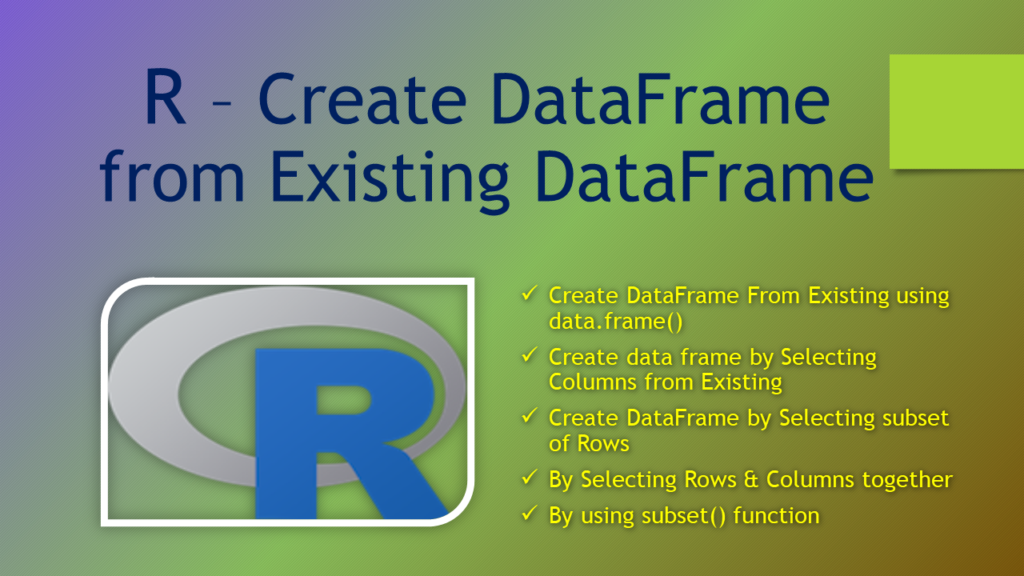You are often required to create a DataFrame from an existing DataFrame in R. When you create from an existing you may be required to select subset of columns or select only a few rows by filtering. This is one of the most use-cases when we are working with the data.
1. Quick Examples
The following are quick examples of how to create a DataFrame from an existing R DataFrame.
# Quick examples
# Example 1 - Select columns id, gender and dob
df2 = data.frame(df$id,df$gender,df$dob)
# Example 2 - Create DataFrame with 1,3 and 4 columns
df2 <- df[,c(1,3,4)]
# Example 3 - Create DataFrame with selecting range of columns
df2 <- df[,c(1:3,5)]
# Example 4 - Create DataFrame with id,gender and name columns
df2 <- df[,c('id','gender','dob')]
# Example 5 - Create DataFrame with 1,3 and 4 rows
df2 <- df[c(1,3,4),]
# Example 6 - Create DataFrame with 1,3,4 rows and columns 2 and 4
df2 <- df[c(1,3,4),c(2,4)]
# Example 7 - By using subset with column names
df2 <- subset(df, select=c("id", "gender", "dob"))
# Example 8 - By using subset with indices
df2 <- subset(df, select=c(2:3, 5))
Let’s create a DataFrame, run these examples and explore the output.
# Create DataFrame
df <- data.frame(
id = c(10,11,12,13),
name = c('sai','ram','deepika','sahithi'),
gender = c('M','M','F','F'),
dob = as.Date(c('1990-10-02','1981-3-24','1987-6-14','1985-8-16')),
state = c('CA','NY','DE','FL')
)
# Print DataFrame
df
# Output
# id name gender dob state
#1 10 sai M 1990-10-02 CA
#2 11 ram M 1981-03-24 NY
#3 12 deepika F 1987-06-14 DE
#4 13 sahithi F 1985-08-16 FL
2. Create DataFrame From Existing using data.frame()
data.frame() method is used to create a DataFrame in R and also is used to create an empty DataFrame. Similarly, you can also use this to create a DataFrame by selecting subset columns and rows from an existing one.
# Create DF by selecting columns id, gender and dob
df2 = data.frame(df$id,df$gender,df$dob)
df2
# Output
# df.id df.gender df.dob
#1 10 M 1990-10-02
#2 11 M 1981-03-24
#3 12 F 1987-06-14
#4 13 F 1985-08-16
Note that column names have data frame prefix if you can rename columns by using R function colnames().
3. Create data frame by Selecting Columns from Existing
You can also create a DataFrame by selecting columns from the existing DataFrame. While selecting the columns you can also by name, indices, and use a range of columns.
# Create DataFrame with id,gender and name columns
df2 <- df[,c('id','gender','dob')]
df2
# Output
# id gender dob
#1 10 M 1990-10-02
#2 11 M 1981-03-24
#3 12 F 1987-06-14
#4 13 F 1985-08-16
The same output can also be achieved by using indices.
# Create DataFrame with 1,3 and 4 columns
df2 <- df[,c(1,3,4)]
df2
Similarly, you also select columns by ranges of indices.
# Create DataFrame with selecting range of columns
df2 <- df[,c(1:3,5)]
df2
4. Create DataFrame by Selecting subset of Rows
To create a DataFrame by selecting subset of rows from the existing DataFrame use the below approach. From the following example df[c(1,3,4),] returns rows 1, 3, and 4.
# Create DataFrame with 1,3 and 4 rows
df2 <- df[c(1,3,4),]
df2
# Output
# id name gender dob state
#1 10 sai M 1990-10-02 CA
#3 12 deepika F 1987-06-14 DE
#4 13 sahithi F 1985-08-16 FL
5. By Selecting Rows & Columns together
using the same approach select the rows and columns together and initialize the DataFrame with the result.
# Create DataFrame with rows 1,3 and 4 and columns 2,4
df2 <- df[c(1,3,4),c(2,4)]
df2
# Output
# name dob
#1 sai 1990-10-02
#3 deepika 1987-06-14
#4 sahithi 1985-08-16
6. By using subset() function
subset() is a R primitive function that is used to select the columns from the DataFrame and assign this result to the variable to create df with the result.
# By using subset with column names
df2 <- subset(df, select=c("id", "gender", "dob"))
df2
# Output
# id gender dob
#1 10 M 1990-10-02
#2 11 M 1981-03-24
#3 12 F 1987-06-14
#4 13 F 1985-08-16
You can also use the subset() to select columns by indices.
# By using subset with indices
df2 <- subset(df, select=c(2:3, 5))
df2
Conclusion
In this article, you have learned several examples of how to create a DataFrame from the existing DataFrame in R. When you create from an existing you may be required to select a subset of columns or select only a few rows by filtering. This is one of the most use-cases when we are working with the data.
Related Articles
- How to Create Empty DataFrame with Column Names in R?
- How to Create a Vector in R
- Create a DataFrame From Vectors in R
- R – How to Create an Empty DataFrame?
- R – Create Empty DataFrame with Column Names?
- How to Create a Vector in R and Access it?
- Create a DataFrame From Vectors in R
- Different Ways to Create a DataFrame in R
